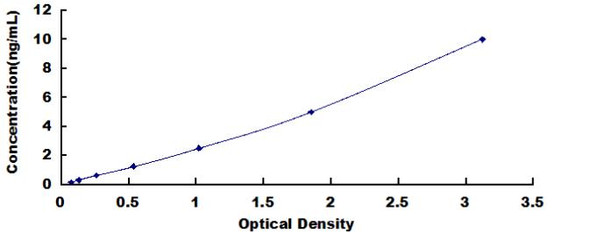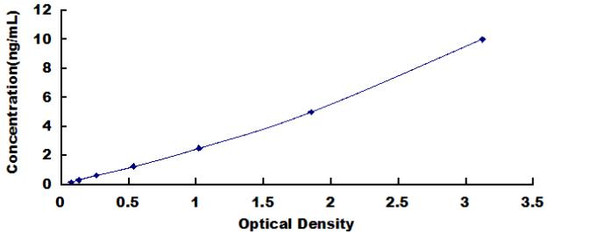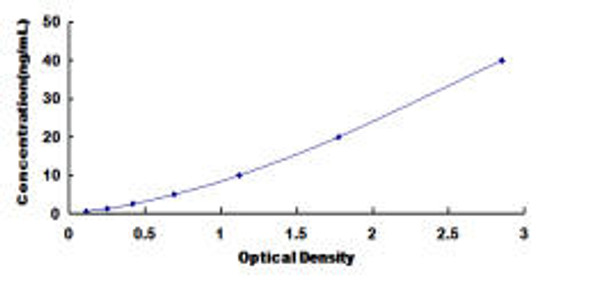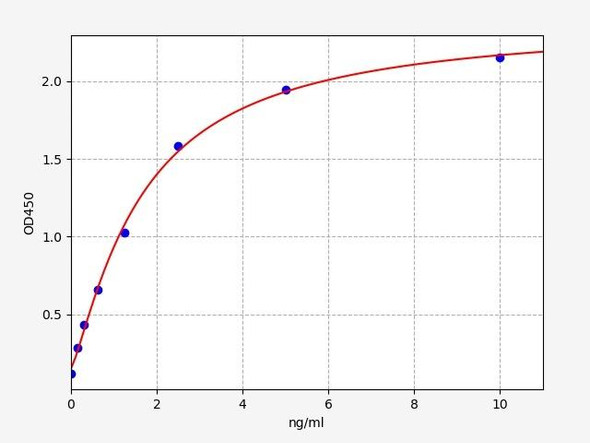Human Cytochrome P450 2C9 (CYP2C9) ELISA Kit (HUEB1822)
- SKU:
- HUEB1822
- Product Type:
- ELISA Kit
- Size:
- 96 Assays
- Uniprot:
- P11712
- Range:
- 0.312-20 ng/mL
- ELISA Type:
- Sandwich
- Synonyms:
- CYP2C9, Cytochrome P450 2C9, Cytochrome P450 MP-4
- Reactivity:
- Human
Description
Human Cytochrome P450 2C9 (CYP2C9) ELISA Kit
The Human Cytochrome P450 2C9 (CYP2C9) ELISA Kit is a cutting-edge tool for the accurate measurement of CYP2C9 levels in human biological samples. This kit is highly sensitive and specific, ensuring precise and reproducible results for a variety of research applications.Cytochrome P450 2C9 is an important enzyme involved in drug metabolism, particularly in the liver. Variations in CYP2C9 activity can impact how individuals metabolize medications, leading to differences in drug efficacy and potential side effects.
By studying CYP2C9 levels, researchers can gain valuable insights into drug metabolism pathways and personalized medicine approaches.Whether studying drug interactions, pharmacogenomics, or liver function, the Human Cytochrome P450 2C9 ELISA Kit provides researchers with a reliable tool for advancing their understanding of CYP2C9 biology and its implications for human health.
| Product Name: | Human Cytochrome P450 2C9 (CYP2C9) ELISA Kit |
| SKU: | HUEB1822 |
| Size: | 96T |
| Target: | Human Cytochrome P450 2C9 (CYP2C9) |
| Synonyms: | (R)-limonene 6-monooxygenase, S-mephenytoin 4-hydroxylase, (S)-limonene 6-monooxygenase, (S)-limonene 7-monooxygenase, CYPIIC9, Cholesterol 25-hydroxylase, Cytochrome P-450MP, Cytochrome P450 MP-4, Cytochrome P450 MP-8, Cytochrome P450 PB-1, CYP2C10 |
| Assay Type: | Sandwich |
| Detection Method: | ELISA |
| Reactivity: | Human |
| Detection Range: | 0.312-20ng/mL |
| Sensitivity: | 0.1ng/mL |
| Intra CV: | 4.2% | ||||||||||||||||||||
| Inter CV: | 8.5% | ||||||||||||||||||||
| Linearity: |
| ||||||||||||||||||||
| Recovery: |
| ||||||||||||||||||||
| Function: | Cytochromes P450 are a group of heme-thiolate monooxygenases. In liver microsomes, this enzyme is involved in an NADPH-dependent electron transport pathway. It oxidizes a variety of structurally unrelated compounds, including steroids, fatty acids, and xenobiotics (PubMed:25994031). This enzyme contributes to the wide pharmacokinetics variability of the metabolism of drugs such as S-warfarin, diclofenac, phenytoin, tolbutamide and losartan (PubMed:25994031). |
| Uniprot: | P11712 |
| Sample Type: | Serum, plasma, tissue homogenates, cell culture supernates and other biological fluids |
| Specificity: | Natural and recombinant human Cytochrome P450 2C9 |
| Research Area: | Cardiovascular |
| Subcellular Location: | Endoplasmic reticulum membrane Peripheral membrane protein Microsome membrane Peripheral membrane protein |
| Storage: | Please see kit components below for exact storage details |
| Note: | For research use only |
| UniProt Protein Function: | CYP2C9: Cytochromes P450 are a group of heme-thiolate monooxygenases. In liver microsomes, this enzyme is involved in an NADPH-dependent electron transport pathway. It oxidizes a variety of structurally unrelated compounds, including steroids, fatty acids, and xenobiotics. This enzyme contributes to the wide pharmacokinetics variability of the metabolism of drugs such as S- warfarin, diclofenac, phenytoin, tolbutamide and losartan. Belongs to the cytochrome P450 family. |
| UniProt Protein Details: | Protein type:Xenobiotic Metabolism - metabolism by cytochrome P450; Oxidoreductase; Lipid Metabolism - linoleic acid; Lipid Metabolism - arachidonic acid; EC 1.14.14.1; Secondary Metabolites Metabolism - limonene and pinene degradation; Cofactor and Vitamin Metabolism - retinol; Xenobiotic Metabolism - drug metabolism - cytochrome P450 Chromosomal Location of Human Ortholog: 10q24 Cellular Component: endoplasmic reticulum membrane; intracellular membrane-bound organelle; cytoplasm Molecular Function:(S)-limonene 6-monooxygenase activity; iron ion binding; heme binding; oxidoreductase activity, acting on paired donors, with incorporation or reduction of molecular oxygen, reduced flavin or flavoprotein as one donor, and incorporation of one atom of oxygen; arachidonic acid epoxygenase activity; (S)-limonene 7-monooxygenase activity; oxidoreductase activity; drug binding; steroid hydroxylase activity; oxygen binding; monooxygenase activity Biological Process: steroid metabolic process; amide metabolic process; drug catabolic process; xenobiotic metabolic process; exogenous drug catabolic process; arachidonic acid metabolic process; monoterpenoid metabolic process; epoxygenase P450 pathway; drug metabolic process; monocarboxylic acid metabolic process; urea metabolic process Disease: Coumarin Resistance |
| NCBI Summary: | This gene encodes a member of the cytochrome P450 superfamily of enzymes. The cytochrome P450 proteins are monooxygenases which catalyze many reactions involved in drug metabolism and synthesis of cholesterol, steroids and other lipids. This protein localizes to the endoplasmic reticulum and its expression is induced by rifampin. The enzyme is known to metabolize many xenobiotics, including phenytoin, tolbutamide, ibuprofen and S-warfarin. Studies identifying individuals who are poor metabolizers of phenytoin and tolbutamide suggest that this gene is polymorphic. The gene is located within a cluster of cytochrome P450 genes on chromosome 10q24. [provided by RefSeq, Jul 2008] |
| UniProt Code: | P11712 |
| NCBI GenInfo Identifier: | 6686268 |
| NCBI Gene ID: | 1559 |
| NCBI Accession: | P11712.3 |
| UniProt Secondary Accession: | P11712,P11713, Q16756, Q16872, Q5VX92, Q6IRV8, Q8WW80 |
| UniProt Related Accession: | P11712 |
| Molecular Weight: | Calculated MW: 18kDa/55kDaObserved MW: 63kDa |
| NCBI Full Name: | Cytochrome P450 2C9 |
| NCBI Synonym Full Names: | cytochrome P450, family 2, subfamily C, polypeptide 9 |
| NCBI Official Symbol: | CYP2C9 |
| NCBI Official Synonym Symbols: | CPC9; CYP2C; CYP2C10; CYPIIC9; P450IIC9 |
| NCBI Protein Information: | cytochrome P450 2C9; cytochrome P-450MP; cytochrome P450 PB-1; microsomal monooxygenase; xenobiotic monooxygenase; flavoprotein-linked monooxygenase; cytochrome P-450 S-mephenytoin 4-hydroxylase |
| UniProt Protein Name: | Cytochrome P450 2C9 |
| UniProt Synonym Protein Names: | (R)-limonene 6-monooxygenase (EC:1.14.13.80); (S)-limonene 6-monooxygenase (EC:1.14.13.48); (S)-limonene 7-monooxygenase (EC:1.14.13.49); CYPIIC9; Cytochrome P-450MP; Cytochrome P450 MP-4; Cytochrome P450 MP-8; Cytochrome P450 PB-1; S-mephenytoin 4-hydroxylase |
| Protein Family: | Cytochrome |
| UniProt Gene Name: | CYP2C9 |
| UniProt Entry Name: | CP2C9_HUMAN |
| Component | Quantity (96 Assays) | Storage |
| ELISA Microplate (Dismountable) | 8×12 strips | -20°C |
| Lyophilized Standard | 2 | -20°C |
| Sample Diluent | 20ml | -20°C |
| Assay Diluent A | 10mL | -20°C |
| Assay Diluent B | 10mL | -20°C |
| Detection Reagent A | 120µL | -20°C |
| Detection Reagent B | 120µL | -20°C |
| Wash Buffer | 30mL | 4°C |
| Substrate | 10mL | 4°C |
| Stop Solution | 10mL | 4°C |
| Plate Sealer | 5 | - |
Other materials and equipment required:
- Microplate reader with 450 nm wavelength filter
- Multichannel Pipette, Pipette, microcentrifuge tubes and disposable pipette tips
- Incubator
- Deionized or distilled water
- Absorbent paper
- Buffer resevoir
*Note: The below protocol is a sample protocol. Protocols are specific to each batch/lot. For the correct instructions please follow the protocol included in your kit.
Allow all reagents to reach room temperature (Please do not dissolve the reagents at 37°C directly). All the reagents should be mixed thoroughly by gently swirling before pipetting. Avoid foaming. Keep appropriate numbers of strips for 1 experiment and remove extra strips from microtiter plate. Removed strips should be resealed and stored at -20°C until the kits expiry date. Prepare all reagents, working standards and samples as directed in the previous sections. Please predict the concentration before assaying. If values for these are not within the range of the standard curve, users must determine the optimal sample dilutions for their experiments. We recommend running all samples in duplicate.
| Step | |
| 1. | Add Sample: Add 100µL of Standard, Blank, or Sample per well. The blank well is added with Sample diluent. Solutions are added to the bottom of micro ELISA plate well, avoid inside wall touching and foaming as possible. Mix it gently. Cover the plate with sealer we provided. Incubate for 120 minutes at 37°C. |
| 2. | Remove the liquid from each well, don't wash. Add 100µL of Detection Reagent A working solution to each well. Cover with the Plate sealer. Gently tap the plate to ensure thorough mixing. Incubate for 1 hour at 37°C. Note: if Detection Reagent A appears cloudy warm to room temperature until solution is uniform. |
| 3. | Aspirate each well and wash, repeating the process three times. Wash by filling each well with Wash Buffer (approximately 400µL) (a squirt bottle, multi-channel pipette,manifold dispenser or automated washer are needed). Complete removal of liquid at each step is essential. After the last wash, completely remove remaining Wash Buffer by aspirating or decanting. Invert the plate and pat it against thick clean absorbent paper. |
| 4. | Add 100µL of Detection Reagent B working solution to each well. Cover with the Plate sealer. Incubate for 60 minutes at 37°C. |
| 5. | Repeat the wash process for five times as conducted in step 3. |
| 6. | Add 90µL of Substrate Solution to each well. Cover with a new Plate sealer and incubate for 10-20 minutes at 37°C. Protect the plate from light. The reaction time can be shortened or extended according to the actual color change, but this should not exceed more than 30 minutes. When apparent gradient appears in standard wells, user should terminatethe reaction. |
| 7. | Add 50µL of Stop Solution to each well. If color change does not appear uniform, gently tap the plate to ensure thorough mixing. |
| 8. | Determine the optical density (OD value) of each well at once, using a micro-plate reader set to 450 nm. User should open the micro-plate reader in advance, preheat the instrument, and set the testing parameters. |
| 9. | After experiment, store all reagents according to the specified storage temperature respectively until their expiry. |
When carrying out an ELISA assay it is important to prepare your samples in order to achieve the best possible results. Below we have a list of procedures for the preparation of samples for different sample types.
| Sample Type | Protocol |
| Serum | If using serum separator tubes, allow samples to clot for 30 minutes at room temperature. Centrifuge for 10 minutes at 1,000x g. Collect the serum fraction and assay promptly or aliquot and store the samples at -80°C. Avoid multiple freeze-thaw cycles. If serum separator tubes are not being used, allow samples to clot overnight at 2-8°C. Centrifuge for 10 minutes at 1,000x g. Remove serum and assay promptly or aliquot and store the samples at -80°C. Avoid multiple freeze-thaw cycles. |
| Plasma | Collect plasma using EDTA or heparin as an anticoagulant. Centrifuge samples at 4°C for 15 mins at 1000 × g within 30 mins of collection. Collect the plasma fraction and assay promptly or aliquot and store the samples at -80°C. Avoid multiple freeze-thaw cycles. Note: Over haemolysed samples are not suitable for use with this kit. |
| Urine & Cerebrospinal Fluid | Collect the urine (mid-stream) in a sterile container, centrifuge for 20 mins at 2000-3000 rpm. Remove supernatant and assay immediately. If any precipitation is detected, repeat the centrifugation step. A similar protocol can be used for cerebrospinal fluid. |
| Cell culture supernatant | Collect the cell culture media by pipette, followed by centrifugation at 4°C for 20 mins at 1500 rpm. Collect the clear supernatant and assay immediately. |
| Cell lysates | Solubilize cells in lysis buffer and allow to sit on ice for 30 minutes. Centrifuge tubes at 14,000 x g for 5 minutes to remove insoluble material. Aliquot the supernatant into a new tube and discard the remaining whole cell extract. Quantify total protein concentration using a total protein assay. Assay immediately or aliquot and store at ≤ -20 °C. |
| Tissue homogenates | The preparation of tissue homogenates will vary depending upon tissue type. Rinse tissue with 1X PBS to remove excess blood & homogenize in 20ml of 1X PBS (including protease inhibitors) and store overnight at ≤ -20°C. Two freeze-thaw cycles are required to break the cell membranes. To further disrupt the cell membranes you can sonicate the samples. Centrifuge homogenates for 5 mins at 5000xg. Remove the supernatant and assay immediately or aliquot and store at -20°C or -80°C. |
| Tissue lysates | Rinse tissue with PBS, cut into 1-2 mm pieces, and homogenize with a tissue homogenizer in PBS. Add an equal volume of RIPA buffer containing protease inhibitors and lyse tissues at room temperature for 30 minutes with gentle agitation. Centrifuge to remove debris. Quantify total protein concentration using a total protein assay. Assay immediately or aliquot and store at ≤ -20 °C. |
| Breast Milk | Collect milk samples and centrifuge at 10,000 x g for 60 min at 4°C. Aliquot the supernatant and assay. For long term use, store samples at -80°C. Minimize freeze/thaw cycles. |










